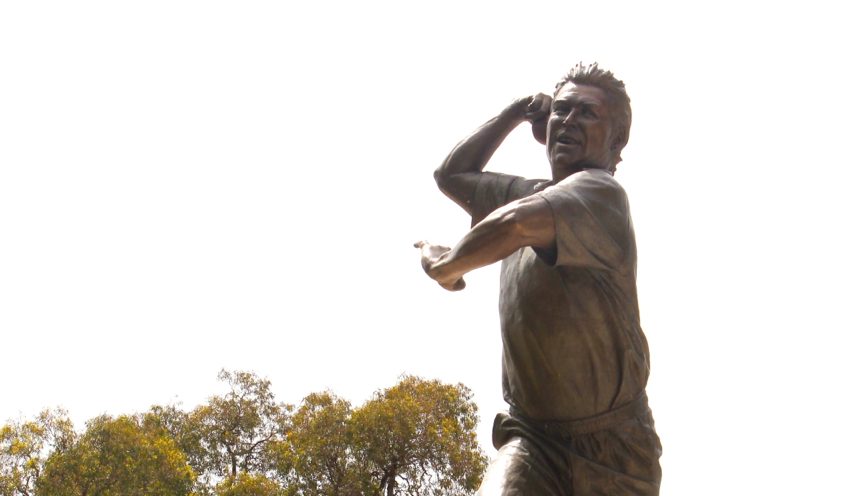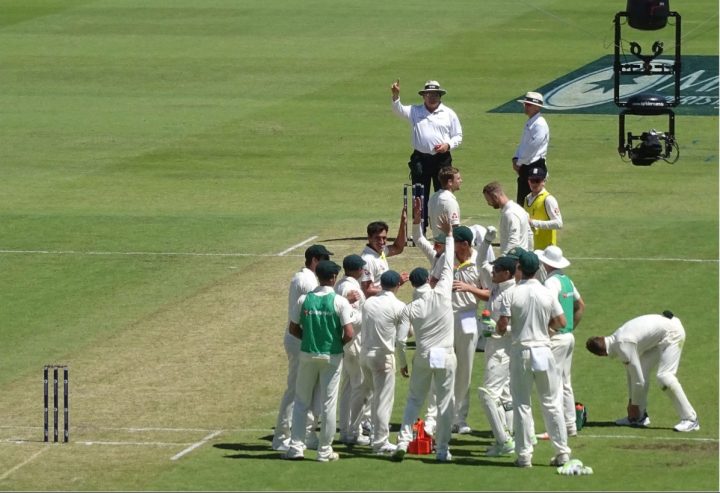Thanks to Rob Thirlwell for this great piece on the travails of an amateur leg spinner…
Every aspect of the game of cricket is challenging. Whether you play on your local village green or at test level you are going to fail far more often than you succeed. There is no harder aspect of the game to master than that of leg spin bowling. You would have to be mad to attempt it. Trying to release a ball out of the back of your hand, whilst imparting sideways movement on it is a crazy enough concept, but that’s only half the battle. You then have to land it in an area no more than a square foot, and if you miss that on either side you’ve either bowled a full toss or a long hop. If it’s too cold you don’t have enough feeling in your fingers to let it go, too hot and you’re too sweaty to hold onto it for long enough.
No captain at an amateur level has trust in their leg spinner. Yes they might grab you a bonus wicket, but if they bowl two bad balls they are off, consigned to another week stood at fine leg watching others, who ply a far safer trade, bowl over after over. It is a pursuit fraught with fear and fragility. Men and women have crumbled under the psychological pressure that results from the pursuit of this uniquely difficult art form. So why then, do so many cricketers still roll out leggies week after week, season after season? For those who started to play after 1993 there can be only one reason, Shane Warne.
In the winter of 2006 to 2007 I was in the early throws of a long and rather tumultuous relationship with the game of cricket. Images of England’s catastrophic Ashes series were beamed around the world into my television screen in the UK. I was struck by a variety of things; Haydos’s power, Ponting’s swivel pull and the pace of Lee. But there was something so mesmerising about watching Warne let go of the ball. How on earth could somebody do that? It went up and down as if it were on a piece of string, all the while the seam rotated perfectly. As it would land the whites of the batter’s eyes glared through the television screen, their fear was palpable. Which way is this going to spin? Could it be a wrong’un? A flipper? Who knows? They all prodded and poked, the master had them tied around his little finger. It was mind-blowing to think that someone who could release the ball at only fifty miles per hour could strike more fear into the heart batters than the bowler at the other end bowling at ninety. From then on I was hooked.
One of the hardest things about being a leg spinner is trying to wrestle back moments in play when the batter is on top. Leggies are unable to use pace to spark fear, they can’t aim at the badge of the batter’s helmet. A lack of intimidation was never a problem for Warne. His flared trousers, flamboyant boots, electric blonde mop of hair and the slosh of zinc on his nose combined to create one of sport’s most iconic looks. He delivered sledges like no other, with complete confidence and certainty and all the ability in the world to back it up. He may have been aware of the potential pitfalls of bowling leg spin, but you could never tell. Each ball was a performance. Ripping the ball out of his right hand, way above his head, catching it in his left, all the while staring the batsmen dead in the eye. A look of malice mixed with excitement would spread across his face as he began to stroll in, then a trot, then a jump and then, magic.
———–
Fear engulfs me as I stand at the top of my mark. Every time, without fail. Anything could happen. Could be a double bouncer, could be a beamer, who knows? These accidents, of which I have been prone to many, are the basis for my recurring nightmares. Watching clips of Warne are the only thing to remedy the fear. I try to place myself in his shoes and be brave. When things went badly for him, he would bounce in, flight it higher and rip it harder. He was a beacon to every young leg spinner and the leader of a strange, flawed, yet hopeful brotherhood.
He convinced thousands that this crazy pursuit was worth the weekly humiliation, pain and fear. For us mere mortals the handful of balls that we have landed in our lifetime have made it a passion worth following. Warne could do it so often. He had no right to execute this impossible skill so regularly and with such enthusiasm.
It is strange to think a man I never met, from the other side of the world has had such an impact on my life. I imagine this sentiment will be shared by countless others. There have been millions of balls spun in hope, endless half trackers and full tosses delivered, oceans of tears shed, occasional balls landed creating wild exhilaration and unrivalled joy, all because of one man, Shane Keith Warne.
Rob Thirlwell









I always thought that one of the many amazing things about Warne was the way he communicated that the whole narrative was always in his hands. His head never dropped’ If a batsman managed to get hold of him and hit him over his head for six, he stood there, his expression and body language suggesting that it was all part of his own master plan and that the stroke had merely made the batsman’s demise more imminent.
A lovely article.
Our games master at school always said that leggies get four for sixty or none for sixty and captains should recognise that fact. He was right. Leggies aren’t there to tie up one end, or keep the rate down or do anything other than take wickets. Warnie showed that, time and again. He was mesmorising, and one of a kind.
Peter Drake, teacher and cricket nut, Hexham
It’s a strange thing that leg spinners are the extremes of the bowling world. Their scarcity of their numbers mean there’s less chance to practice against them. The greats always seem to get loads of wickets and the rest of them who find the awkward control and spin aspects more difficult, go for plenty, which would explain why leg spin has so few successful protagonists and indeed relatively few protagonists atall.
Has Warne introduced a bevy of successful leggies, clearly not. Even his charisma cannot force the issue for an art that is so difficult for the human frame to master as there’s almost nothing natural about it.
Hi Rob,
Nice blog. I was personally shocked and sad on hearing the news. Here is my blog and tribute to Shane Warne.
https://vsivaji.wixsite.com/stumpmic/post/shane-warne-lessons-for-our-life
Thanks and Regards,
Sivaji Venkat
I think one thing that people have lost sight of with the clips of Warne’s wickets in the media following news of his death, is that whilst he certainly took wickets with some brilliant balls, he was a thinking cricketer who did a lot of the psychological damage to a batsman with earlier deliveries. He often out thought even top quality batsmen, softening them up with the flipper before delivering a ball which turned viciously. A true great.
Part of the problem with Warne is that he was so good all other wrist-spinners tended to be compared to him. Very few could be both strike bowler and stock bowler in the way he could and they suffered in the eyes of most coaches and captains as a result. T20 has done more to bring a permanent renaissance of leg-spin than Warne.
Warne’s quality meant he was as great a one-day bowler as he was in Tests. One of his greatest was in that classic 1999 WC SF. People tend to remember that game’s climax but Australia would’ve been long out of the game if warne hadn’t derailed SA’s top order.
One personal memory – and a rare occasion Warne was bested – was in a one-day match I saw at Southampton against Notts. David Hussey gave Warne a thrashing down the ground, hitting the kind of low trajectory sixes that are difficult to pick up in the crowd. One six hit a spectator near me full in the face followed by another spectator trying to catch a six, tripping over the seats and landing head first on concrete. Even Warney was struggling to make all this look like part of his masterplan….
Did he get him I the end, Simon? What were his final figures ? He never minded trading runs for wickets !
A wonderful article that really hit home for me. I grew up watching Shane and wanted to bowl legspin above everything else. The anecdote of bowling a bad over in a school or club match and then being hoiked off for one of our many medium (although they would say fast) bowlers to bowl another spell of “safe” bowling rings very true!
Over time I gradually transitioned to bowling offspin and darts as a way of making sure I could get a good spell in, often with the captain and coach reminding me “to keep it tight and not give it any air”… yet the temptation to bowl the big leg break was always dangling there.
Warne was, is and forever will be the gold standard in my mind. And my spell this past weekend shows the impact that Warne has had on my cricketing career, a wicket with a leg break first ball followed by going for three successive fours and a stern talking to me by the skipper…
What a glorious article, Rob. Quite the best tribute to Warney of the many I’ve read. If you’re still purveying leg spin, keep believing that you’ll land the next one. And let’s hope your skipper keeps you on until you do. Years ago I witnessed what I believe to be the most eccentric over ever bowled. A Second XI club match in southern Scotland, where the overheads and the pitches are disincline to aid the wrist spinner. Our more conventional ‘attack’ was getting nowhere, so our skipper, with no one else to turn to, unleashed our occasional, somewhat eccentric leggie to see if he could dislodge an opening partnership that had moved smoothly past 100. Our secret weapon, by the name of Michael Wheatley, then produced the ultimate leg-spinner’s over. My memory may be failing, but I think the six balls went thus: 6 – W – W – 6 – 6- W. (It might have been W – 6 – W – 6 – 6 – W, but the outcome remained the same. A bowling analysis of 1 – 0 – 18 – 3. Yay! The perfect over! Honestly, this really happened. From that day onwards, I’ve regarded leg-spin as a magical part of cricket, and thanks to Warnie a couple of generations have been able to marvel at it. Otherwise it might have been lost to us, with apologies to Abdul Qadir and Stuart McGill.